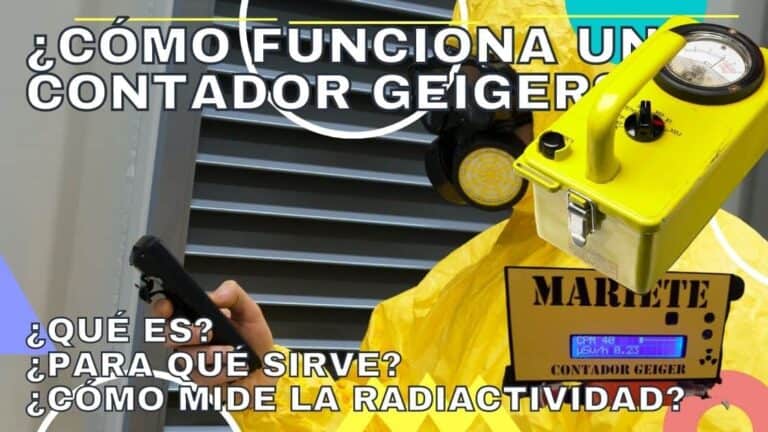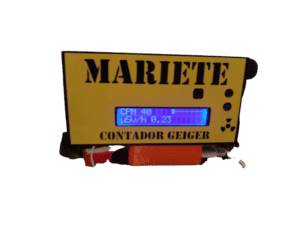Have you ever wondered how a Geiger counter works and how it can be used? how to measure radioactivity? In this article we will look at how a Geiger counter works so that you can easily understand it.
Contents
What is a Geiger counter?
A meter or Geiger counter-Müller is a device used to measure and detecting ionising radiation.
Its operation is based on the fact that when the ions that produce these radiations pass through the active volume of the detector they are accelerated by an electric fieldThe current pulse signals the passage of radiation.
Geiger counters are part of a family of radiation detectors called "...".gas detectors". These detectors, as the name suggests, are full of gas (some kind of inert gas at low pressure, about 0.1 atmospheres).
They have an electrode in the centre of the chamber and are configured in such a way that there is an electrical voltage between the electrode and the metal wall of the chamber.
This is how a Geiger counter works
At the moment the radiation hits the gas molecules in the tube, separates electrons from atomsThis process is called ionisation. The electron is attracted by the effective charge of the anode and the rest of the atom (a positively charged ion) is thrown towards the tube wall. The electron then travels through the wires that form the electrical circuit and recombines with the ion. Part of the Geiger counter is a device that measures this electron flow.
Geiger-Mueller tube
Of course, it is very difficult to measure a single electronFortunately, the instruments do not need to do so. At the moment the electron and ion are accelerated towards the electrode and the chamber walls gain A LOT of energy due to the high voltage, they collide with other atoms and suppress electrons from in a process called secondary ionisation. Those electrons and, and also ions, in turn, cause even more ionisations and so on repeatedly, this amplifies the original signal at a very high leveluntil it reaches a point where the signal can be measured.
The creation of discrete avalanches in a proportional counter
In a Geiger counter, the voltage is so high that the whole gas chamber is ionisedThis gives a very high sensitivity to the incoming radiation. In other detectors (so-called ion chamber and proportional counters) the voltage is lower and the gas amplification ratio is also lower; only a few gas atoms are ionised in these detectors. The amplification ratio with increasing voltage is shown in the graph below.

To make sense of this graph, mainly by trying to understand how a Geiger counter works and some of its limitations, it is useful to know that alpha particles have considerably more energy than beta particles.
In addition, it helps to know that radiation dose is a measure of the proportion of energy that is deposited by radiation on an element, more energy means more doses.
Thus, looking at this graph, we can see that high energy radiation hitting a detector leaves a higher signal than low energy radiation.
Now look at the right-hand side of the graph, the Geiger-Muller region; in this region high-energy radiation generates exactly the same signal as low-energy radiation. So, we do not have the possibility to distinguish between high-energy radiation and low-energy radiation, which means that we do not have the possibility to always tell how much radiation dose an individual was exposed to if we are only measuring with a Geiger counter. This is one reason why not in all cases we have the possibility to use a Geiger counter to measure the radiation dose rate accurately..
If a Geiger counter, among other things, is calibrated to measure the radiation dose rate of the radionuclide Cs-137, it will be really useful if and when one tries to measure the radiation dose of this nuclide.
So far we have seen how a Geiger counter works in a simple way, but it is important to know that there are drawbacks to this type of radiation meter.
Limitations of Geiger counters
But what if you are trying to measure the radiation from cobalt-60 (Co-60)?
Well, then you're going to have a bit of a snag: the radiation of Co-60 has twice the energy of that of Cs-137so whatever the detector reads will be only half of the actual radiation dose. On the other hand, several radionuclides have lower energy. In such a case, your meter will read a higher dose rate than it is anyway. The end result is that a Geiger counter will only give an accurate radiation dose rate reading if it is measuring exactly the same radioactive material with which it was calibrated.. Hence, Geiger counters are not always the right instruments to measure radiation dose rates.
It turns out that there is a type of Geiger tube that will give very accurate readings of a wide range of radiation energies. energy compensated Geiger counters. These are designed to give a constant reading over a wide range of radiation energies, so if you are using an energy compensated GM detector you can take accurate dose rate readings. Otherwise, it may be better to carry out dose rate measurements with an ion chamber.
One more thing about Geiger counters: They are large general purpose radiation detectors because they have the possibility to measure the alpha, beta and gamma radiation. If you are measuring gamma radiation, you may be more interested in measuring the dose rate (measured in mR/hr or, for really low scenarios, µR/hr - microR per hour). If you are measuring alpha or beta radiation, then you are probably trying to find contamination and should measure counts per minute (cpm) or counts per second (cps), depending on the type of meter you are using.
Summary of the characteristics of a Geiger counter
- gas-filled detectors (such as Geiger counters and ion chambers) are filled with a gas to which an electric voltage is applied.
- When the radiation interacts with the gas it causes ionisations, and this small signal is amplified by the electric voltage. The amplification ratio is voltage dependent..
- Ion chambers have the possibility to measure the difference in the energy of the radiation, which is why they are special measures to measure the radiation dose rate.
- Geiger counters, on the other hand, have full signal amplification for any radiation energy that reaches them. For this reason, not all cases give accurate readings of the dose ratemainly if the radiation energy is different from that which was calibrated.
- Having said that, GM energy compensated detectors are designed to help solve this problem, now that they offer very accurate dose rates over a wide range of radiation energies.
- And finally, Geiger counters also have the possibility of measuring not only radiation dose gamma (measured in mR/hr or µR/hr), but rather in addition to the contamination alpha and beta (measured in cps or cpm).
I hope you enjoyed this basic explanation. If you did not find it enough and you want to learn more about how a Geiger counter works, I recommend you to see this wikipedia article.
Do you want to have your own Geiger-Müller counter?
I bought my Geiger counter as a kit several years ago and it was very easy to assemble. It has been working very well ever since.
If you want to have yours, here you have one. selection of best-selling Geiger counter kits to make it easy for you to find the one that's right for you.
No products found.
Maybe you don't like electronics and gadgetry so much and you prefer to buy a finished Geiger counter. If so, here are these options:
No products found.




Very good explanation.
Thank you.